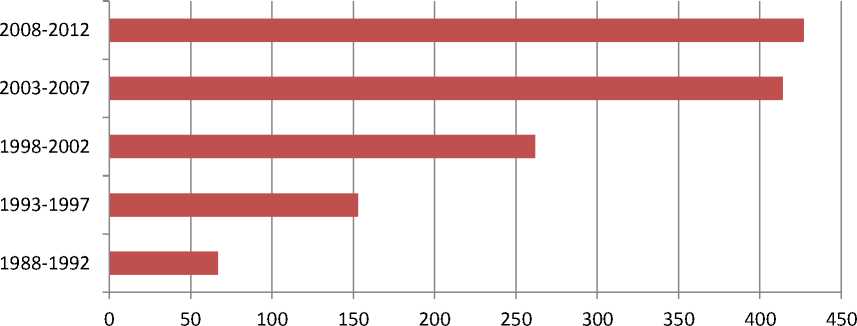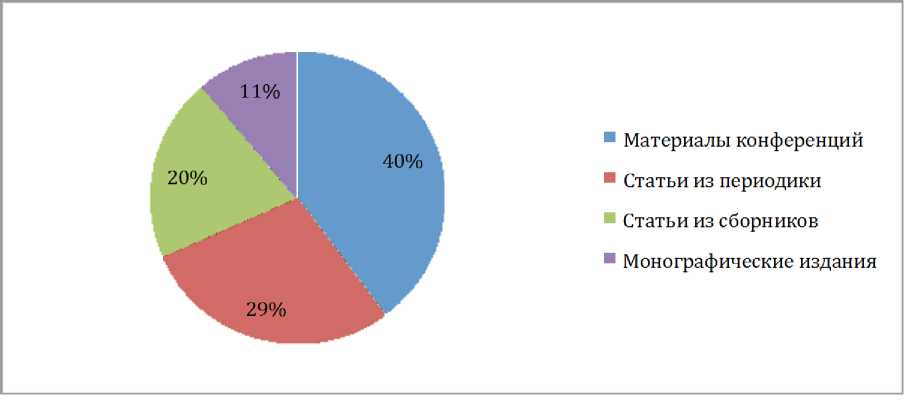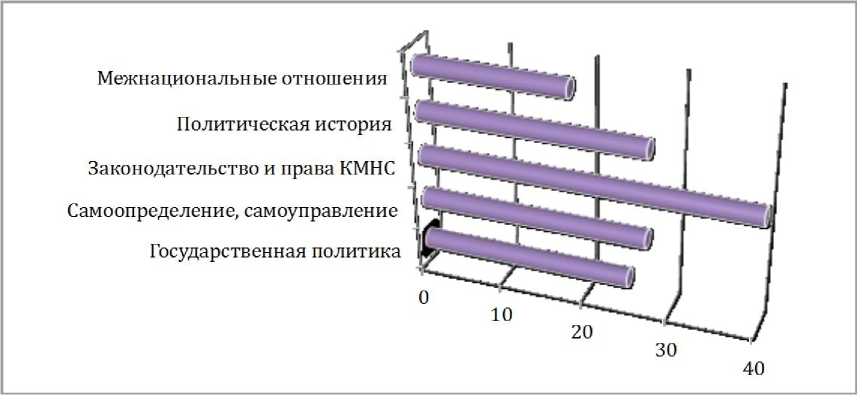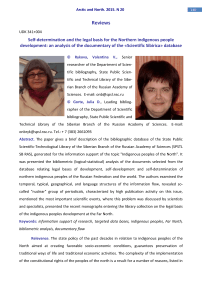Self-determination and the legal basis for the Northern indigenous people development: an analysis of the documentary of the «Scientific Sibirica» database
Автор: Rykova Valentina V., Gorte Julia D.
Журнал: Arctic and North @arctic-and-north
Рубрика: Reviews and reports
Статья в выпуске: 20, 2015 года.
Бесплатный доступ
The paper gives a brief description of the bibliographic database of the State Public Scientific-Technological Library of the Siberian Branch of the Russian Academy of Sciences (SPSTL SB RAS), generated for the information support of the topic "Indigenous peoples of the North". It was presented the bibliometric (logical-statistical) analysis of the documents selected from the database relating legal bases of development, self-development and self-determination of northern indigenous peoples of the Russian Federation and the world. The authors examined the temporal, typical, geographical, and language structures of the information flow, revealed socalled "nuclear" group of periodicals, characterized by high publication activity on this issue, mentioned the most important scientific events, where this problem was discussed by scientists and specialists, presented the recent monographs entering the library collection on the legal basis of the indigenous peoples development at the Far North.
Information support of research, targeted data bases, indigenous peoples, Far North, bibliometric analysis, documentary flow
Короткий адрес: https://sciup.org/148318714
IDR: 148318714 | УДК: 341+004
Текст научной статьи Self-determination and the legal basis for the Northern indigenous people development: an analysis of the documentary of the «Scientific Sibirica» database
Relevance. The state policy of the past decades in relation to indigenous peoples of the North aimed at creating favorable socio-economic conditions, guarantees preservation of traditional ways of life and traditional economic activities. The complexity of the implementation of the constitutional rights of the peoples of the north is a result for a number of reasons, listed in the monograph by S.N. Kharyuchi. One of them is the relative small amount of people, living in extreme climatic conditions, deprived of the opportunity of choice other means of livelihood in addition to traditional, distanced from developed economic areas and limited cooperation with other peoples of Russia [1, 2008].
Materials and methods. The study of the problems of indigenous peoples of the Arctic and ways to solve them requires a modern information support. In order to ensure the infor-mation needs of scientists and experts engaged in studies of various aspects of life of indigenous peoples of the northern regions and development of recommendations and programs of sustainable development, the State Public Scientific and Technical Library of the Siberian Branch of the Russian Academy of Sciences (SPSTL SB RAS) has established a problem-oriented bibliographic database “Indigenous peoples of the North” [2, 2009]. Information array of the database can serve as a significant source of information for scientific research on a wide range of issues related to indigenous peoples. This database is designed to provide information support on a wide range of problems (social, economic, political, ethno-ecological, socio-medical, cultural and historical) of northern peoples. A distinctive feature of the database is its objective, geographic and ethnographic headings that make it possible for bibliometric analysis of the documentary flows (DF) on one or another problem of development of northern peoples or the range of issues concerning one the peoples or indigenous problems within the same region. Bibliometric (Logical and statistical) analysis provides information about the structure (type, chronology, theme, language and etc) of the documentary flow, data on productive base sources of information [3, 2000].
The volume of problem-oriented DB. In December 2014 it amounted to about 24,000 documents for the period 1988—2014. In 2011, DB “Indigenous Peoples of the North” was included in a thematic section with its subject categories in bibliographic DB “Scientific Siberica”, freely available at the SPSTL SB RAS website for all categories of users.
Geographical coverage of the DB. It is large and includes materials on the northern areas of Siberia, the Far East, the European North of Russia (Arkhangelsk, Murmansk region, the Republic of Karelia and Komi) and polar regions overseas — Sweden, Finland, Norway, the United States (Alaska), Canada and Denmark (Greenland). The sources of the selection line for the establishment and replenishment of this database is a mandatory copy of Russian literature and foreign publications coming into SPSTL and materials from remote databases. Each docu-ment contains a full bibliographic description, the abstract, geographic headings, translations for foreign publications, sections. Search is possible for key words, authors, editors, year and place of publication, location or subjects, language and type of publication. If necessary, you can combine the fields and use “complex” search by several parameters.
From a thematic section “Indigenous People of the North” a flow of documentary on legal issues, development and self-government was selected and a bibliometric analysis held.
Results . The term structure of the documentary flow over a 25-year period is represented in the diagram (Pic. 1); growing interest researchers to the aforesaid problem in the last decade is clearly observed.

Picture 1. Documentary flow dynamics
Publications made in 2013—2014 are more actively enter the library funds, therefore they are excluded from the diagram; but their number is more than 300 documents by now and we can predict further growth.
The round diagram reflects the specific structure of the documentary flow where conference materials (40%) prevail. It should be noted that the scientific meetings play an important role in the exchange of information between scientists and specialists and their materials allow them to evaluate the state of modern fundamental and applied research. Regularity of scientific meetings at various levels on various aspects of studying the indigenous peoples of the North is a testament to the active work of specialists in this field.
It is impossible to list all of the conferences, focused on the indigenous issues. So just to name a few: permanent “Congress of ethnographers and anthropologists of Russia”, and “Legal problems of Norway and Russia”: Northern Dimension” (Arkhangelsk, 2010)," “Indigenous People in contemporary legal environment: challenges, priorities and prospects” (Khanty-Mansiysk, 2012), “Man in History: North-East frontier of Russia in the context of the political, economic, ethno-social and ethno-cultural processes of XVII — beginning of the XXI century” (Petropavlovsk-Kamchatsky, 2012), “The Arctic regions of Russia: problems of parliamentta-rianism, represen- tation and regional identity. From tribal communities — to Parliament of Yamal” (Salekhard, 2012), “Political, economic and socio-cultural aspects of regional management in the European North” (Syktyvkar, 2013) and many others.

Picture 2. Type structure of the DB
More than half of publication consists of articles from periodicals (29%) and collections of scientific papers (20%), where the latest achievements of scientists and specialists are reflected. The most reliable periodicals on indigenous issues could be divided into two groups: 1) journals publishing laws and regulations: Gosudarstvo i Pravo of the Russian Federation”,"Bulletin of normativnih aktov federativnih organov ispolnitelnoi vlasti"; 2) journals publishing scientific articles: “Gosudarstvo i pravo”, “Rossijskaya Federaciya segodnya”, “Istori-cheskie, filosofskie, politicheskie i yuridicheskie nauki, kul'turologiya i iskusstvovedenie. Voprosy teorii i praktiki”, “Vestnik Soveta Federacij”, “Etnosocialnye processy v Sibiri”, “Konstitucionnoe i municipalnoe pravo”. Indigenous issues are covered on the pages of university perio-dicals (North East, Northern (Arctic), Novosibirsky and Sibirsky Federal Universities).
The diagram shows that the rights of indigenous peoples of the North are the most actively studied issues. The works devoted to the analysis of inter-ethnic relations in indigenous areas are not numerous.
The main contribution to the study of the legal issues of development, self-development and local self-government are introduced by institutes of the Russian Academy of Sciences: Institute of Ethnonology and Anthropology (Moscow), Institute of Philosophy and Law (Novosibirsk), Institute of Humanitarian Research and Indigenous Peoples of the North of SB RAS (Yakutsk), Institute of Language and Literature and History of Karelian Research Center of RAS (Petrozavodsk). Research is done by university teachers from: the North-Eastern Federal University, Tyumen State University, Northern (Arctic) Federal University, Moscow State University,
Komi Republican Academy of State services and Management, and others. It should be noted that universities publish monographs and textbooks online [7, 2013; 12, 2012].

Picture 3. Theme structure of monographs
Among the authors S.N. Gorbunov should be mentioned [20, 21, 22, 23]. He is dealing with the study of the rights of indigenous peoples of the North. In geographical terms the most active materials on the legal framework, development issues, self-determination and self-development of indigenous peoples of the Arctic are published in the Republic of Sakha (Yaku-tia), the Khanty-Mansi and Yamalo-Nenets Autonomous Districts, as well as in the European North of Russia.
The language structure of the analyzed information flow is rather homogeneous — more than 90% of the documents are published in Russian, the other materials presented in English.
Conclusion
Bibliometric analysis of documentary flows on legal aspects of development, self-determination and self-development of Indigenous Peoples of the North has shown its dynamics, specific, geographic, linguistic structure; revealed groups of magazines, “fresh” monographs. Information array of the problem-oriented bibliographic databases such as “Indigenous peoples of the North” can serve an important foundation for research on a broad range of issues concerning indigenous peoples. Materials are available for all researchers. Information from the database of own SPSTL generation is possible to find at (“Resources and Services” → “on-line catalogs and databases”→ “bibliographic database”→ “Scientific Sibirica”→ “Indigenous People”).
Список литературы Self-determination and the legal basis for the Northern indigenous people development: an analysis of the documentary of the «Scientific Sibirica» database
- Harjuchi S.N. Pravovye problemy korennykh malochislennykh narodov Severa Rossii [Legal problems of indigenous scanty peoples of the North in Russia]. Moscow, JuNITI-DANA: Zakon i pravo, 2008. 271 p.
- Rykova V.V. Baza dannykh sobstvennoy generatsii GPNTB SO RAN «Korennye malochislennye narody Severa»: kharakteristika, analiz dokumentopotoka [Database “Indigenous peoples of the North”: description ,analysis of the documentary]. Vestnik arkheologii, antropologii i etnografii. 2009, no. 10, pp. 90—95.
- Zusman O.M. Bibliograficheskie issledovaniya nauki [Bibliographic research of science]. St. Petersburg, 2000. 216 p.
- Ahmetova A.V. Vlast' i etnos: sotsial'naya politika sovetskogo gosudarstva v otnoshenii korennykh malochislennykh narodov Dal'nego Vostoka (1925—1985 gg.) [Authority and ethnos: the social policy of the Soviet state in relation to indigenous scanty peoples of the Far East (1925—1985)]. Vladivostok, Dalnauka, 2013. 168 p.
- Ahmetova, A.V. Sovetskoe gosudarstvo i korennye malochislennye narody Dal'nego Vostoka: ucheb. Posobie [The Soviet state and indigenous scanty peoples at the Far East: manual]. Komsomolsk-na-Amure, 2012. 175 p.
- Garipov R. S. Zashchita korennykh narodov v mezhdunarodnom prave [The defence of indigenous peoples in the international law]. Kazan, Centrinnovac. tehnologij, 2012. 256 p.
- Gogolev P.V. Mestnoe upravlenie narodov Yakutii: istoriya, traditsii, sovremennost [Local government of Yakutian peoples: history, traditions, modernity]. Jakutsk: SVFU, 2013. 1 CD.
- Gorbunov S. N., Zadorin M. J. Korennye narody i ustoychivoe razvitie [Indigenous peoples and sustainable development]. Arhangelsk, SAFU, 2014. 358 p.
- Grazhdanskaya, etnicheskaya i regional'naya identichnost': vchera, segodnya, zavtra [Civil, ethnic, and regional identity: yesterday, today, tomorrow] ed. L. M. Drobizheva. Moscow, ROSSPJeN, 2013. 485 p.
- Erohina EA Sibirskiy vektor vnutrenney geopolitiki [RossiiThe Siberian vector of the home policy in Russia]. Novosibirsk: NGU, 2012. 417 p.
- Zhukov A. J. Samoupravlenie v politike Rossii: Kareliya v XII — nachale XVII v [Self-government in the Russian polivy: Karelia in XII — early XVII centuries]. Petrozavodsk, KNC RAN, 2013. 491 p.
- Kilin J. M. Sovetskaya Kareliya v 1939—1941 gg.: ot avtonomii k soyuznoy respublike [Soviet Karelia in 1939—1941: from autonomy to republic]. Petrozavodsk, PetrGU, 2012. 1 CD.
- Plotskaya O.A. Obychnoe etnicheskoe pravo komi (zyryan) [Common ethnic rights of Komi (Zyryane)]. Syktyvkar, Izd SyktSU, 2013. 232p.
- Sirina A.A. Evenki i eveny v sovremennom mire: samosoznanie, prirodopol'zovanie, mirovozzrenie [Evenks and Evens in the modern world: self-consciousness, nature management, world-view]. Moscow, Vostochnaja literatura, 2012. 604 p.
- Sovetskaya natsional'naya politika: ideologiya i praktika, 1945—1953 [Soviet na-tionnal policy: ideology and practice, 1945—1953].Moscow, ROSSPJeN, 2013. 926 p.
- Sushko A.V. Protsessy suverenizatsii narodov Sibiri v gody Grazhdanskoy voyny [Pro-cesses of people's sovereignty in Siberia during the Civil War. 2nd ed.]. Moscow, URSS: LENAND, 2014. 368 p.
- Trofimov E.N. Rossiya mnogonatsional'naya. Politiko-pravovye osnovy upravleniyanatsional'nymi protsessami (1906—2012 gody) [Russia is a non-national state. Political-legislative bases of national processes control (1906—2012)]. Moscow, Logos, 2013. 373 p.
- Fedorov V.I. Yakutiya v epokhu voyn i revolyutsiy (1900—1919) [Yakutia at the epoch of wars and revolutions (1900—1919)]. Novosibirsk, Geo, 2013. 676 p.
- Khalturin A.N. Pravo kak sotsialnyy regulyator etnokulturnogo vzaimodeystviya na Kol'skom Severe [Law as a social regulator of ethnic-cultural relations at the Kola North]. Arhangelsk, KIRA, 2014. 338 p.
- Gorbunov S.N., Molchanov B.A., Falileev N. Y. Istoriko-pravovye aspekty formirovaniya pravovogo statusa korennykh narodov [Historical-legislative aspects of forming the legal status of indigenous peoples]. Moscow-Arkhangelsk, Jupiter, 2007. 433 p.
- Gorbunov S. N., Zadorin M. Y. Korennye narody i ustoychivoe razvitie [Indigenous peoples and sustainable development]. Arkhangelsk, SAFU, 2014. 358 p.
- Gorbunov S.N. Prava korennykh narodov na blagopriyatnuyu okruzhayushchuyu sredu [Indigenous peoples' rights to healthy environment]. Vladimir, 2002. 198 p.
- Gorbunov S. N. Pravo na okruzhayushchuyu sredu kak uslovie ustoychivogo razvitiya korennykh narodov [The right to the environment as a condition for sustainable development of indigenous peoples]. Arkhangelsk, Pomorsky Univ., 2005. 312 p.


